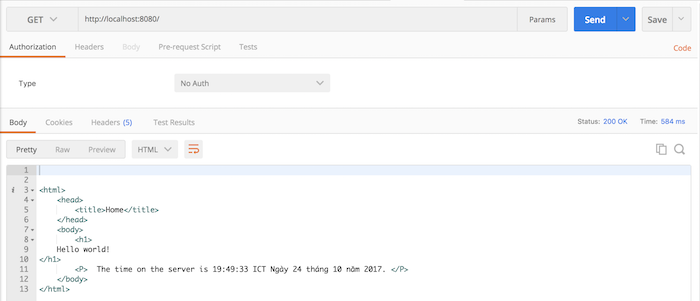The @RequestMapping annotation beside allows us to define the request URL, it also allows us to define the HTTP request method for the controller in Spring MVC using its method attribute. In this tutorial, we will learn more about this method property.
In the project that I created in the previous tutorial, the home() method defines an @RequestMapping annotation with the value of the method attribute RequestMethod.GET.
|
1 2 3 4 5 6 7 8 9 10 11 12 13 14 15 16 17 18 19 20 21 22 23 24 25 26 27 28 29 30 31 32 33 34 35 36 37 38 39 |
package com.huongdanjava.springmvc; import java.text.DateFormat; import java.util.Date; import java.util.Locale; import org.slf4j.Logger; import org.slf4j.LoggerFactory; import org.springframework.stereotype.Controller; import org.springframework.ui.Model; import org.springframework.web.bind.annotation.RequestMapping; import org.springframework.web.bind.annotation.RequestMethod; /** * Handles requests for the application home page. */ @Controller public class HomeController { private static final Logger logger = LoggerFactory.getLogger(HomeController.class); /** * Simply selects the home view to render by returning its name. */ @RequestMapping(value = "home", method = RequestMethod.GET) public String home(Locale locale, Model model) { logger.info("Welcome home! The client locale is {}.", locale); Date date = new Date(); DateFormat dateFormat = DateFormat.getDateTimeInstance(DateFormat.LONG, DateFormat.LONG, locale); String formattedDate = dateFormat.format(date); model.addAttribute("serverTime", formattedDate); return "home"; } } |
This means that the user accesses this request URL with the GET method.
The org.springframework.web.bind.annotation.RequestMethod is the object that defines the request methods for Spring MVC.
The methods that the @RequestMapping annotation supports are defined in the org.springframework.web.bind.annotation.RequestMethod enum as follows:
- GET
- HEAD
- POST
- PUT
- PATCH
- DELETE
- OPTIONS
- TRACE
Let’s take another example.
|
1 2 3 4 |
@RequestMapping(value = "doLogin", method = RequestMethod.POST) public String doLogin(HttpServletRequest request) { return "home"; } |
As you can see, here I have defined a request with the POST method.
By default, when using the @RequestMapping annotation, if you do not define method attribute, the request method will be GET, POST, or HEAD. Outside these request methods, if you request other methods, 405 errors will occur.
For example:
|
1 2 3 4 5 6 7 8 9 10 11 12 13 14 15 16 17 18 19 20 21 22 23 24 25 26 27 28 29 30 31 32 33 34 35 36 37 38 |
package com.huongdanjava.springmvc; import java.text.DateFormat; import java.util.Date; import java.util.Locale; import org.slf4j.Logger; import org.slf4j.LoggerFactory; import org.springframework.stereotype.Controller; import org.springframework.ui.Model; import org.springframework.web.bind.annotation.RequestMapping; /** * Handles requests for the application home page. */ @Controller public class HomeController { private static final Logger logger = LoggerFactory.getLogger(HomeController.class); /** * Simply selects the home view to render by returning its name. */ @RequestMapping(value = "home") public String home(Locale locale, Model model) { logger.info("Welcome home! The client locale is {}.", locale); Date date = new Date(); DateFormat dateFormat = DateFormat.getDateTimeInstance(DateFormat.LONG, DateFormat.LONG, locale); String formattedDate = dateFormat.format(date); model.addAttribute("serverTime", formattedDate); return "home"; } } |
Result:

Or

From version 4.3 onwards, Spring introduces a number of annotations to make it easier to declare the method call. These are the following annotations:
- Annotation @GetMapping for the GET method.
- Annotation @PostMapping for the POST method.
- Annotation @PutMapping for the PUT method.
- Annotation @DeleteMapping for the DELETE method.
- Annotation @PatchMapping for the PATCH method.
Now we do not need to declare:
|
1 |
@RequestMapping(value = "/", method = RequestMethod.GET) |
just declare:
|
1 |
@GetMapping(value = "/") |
If you look at the @GetMapping annotation code then you’ll understand why we just use the @GetMapping annotation without using the @RequestMapping annotation anymore.
|
1 2 3 4 5 6 7 8 9 10 11 12 13 14 15 16 17 18 19 20 21 22 23 24 25 26 27 28 29 30 31 32 33 34 35 36 37 38 39 40 41 42 43 44 45 46 47 48 49 50 51 52 53 54 55 56 57 58 59 60 61 62 63 64 65 66 67 68 69 70 71 72 73 74 75 76 77 78 79 80 81 82 83 84 85 86 87 88 89 90 91 92 |
/* * Copyright 2002-2016 the original author or authors. * * Licensed under the Apache License, Version 2.0 (the "License"); * you may not use this file except in compliance with the License. * You may obtain a copy of the License at * * http://www.apache.org/licenses/LICENSE-2.0 * * Unless required by applicable law or agreed to in writing, software * distributed under the License is distributed on an "AS IS" BASIS, * WITHOUT WARRANTIES OR CONDITIONS OF ANY KIND, either express or implied. * See the License for the specific language governing permissions and * limitations under the License. */ package org.springframework.web.bind.annotation; import java.lang.annotation.Documented; import java.lang.annotation.ElementType; import java.lang.annotation.Retention; import java.lang.annotation.RetentionPolicy; import java.lang.annotation.Target; import org.springframework.core.annotation.AliasFor; /** * Annotation for mapping HTTP {@code GET} requests onto specific handler * methods. * * <p>Specifically, {@code @GetMapping} is a <em>composed annotation</em> that * acts as a shortcut for {@code @RequestMapping(method = RequestMethod.GET)}. * * * @author Sam Brannen * @since 4.3 * @see PostMapping * @see PutMapping * @see DeleteMapping * @see PatchMapping * @see RequestMapping */ @Target(ElementType.METHOD) @Retention(RetentionPolicy.RUNTIME) @Documented @RequestMapping(method = RequestMethod.GET) public @interface GetMapping { /** * Alias for {@link RequestMapping#name}. */ @AliasFor(annotation = RequestMapping.class) String name() default ""; /** * Alias for {@link RequestMapping#value}. */ @AliasFor(annotation = RequestMapping.class) String[] value() default {}; /** * Alias for {@link RequestMapping#path}. */ @AliasFor(annotation = RequestMapping.class) String[] path() default {}; /** * Alias for {@link RequestMapping#params}. */ @AliasFor(annotation = RequestMapping.class) String[] params() default {}; /** * Alias for {@link RequestMapping#headers}. */ @AliasFor(annotation = RequestMapping.class) String[] headers() default {}; /** * Alias for {@link RequestMapping#consumes}. * @since 4.3.5 */ @AliasFor(annotation = RequestMapping.class) String[] consumes() default {}; /** * Alias for {@link RequestMapping#produces}. */ @AliasFor(annotation = RequestMapping.class) String[] produces() default {}; } |


